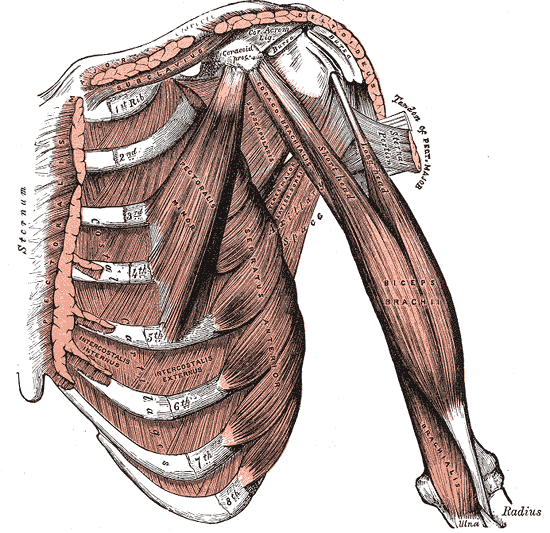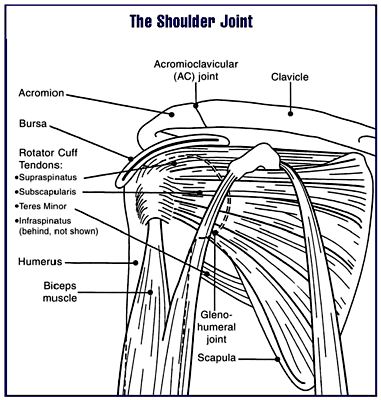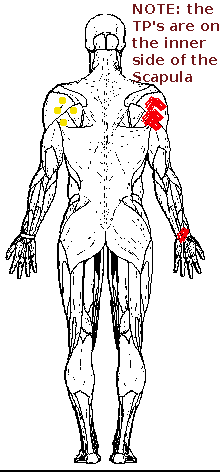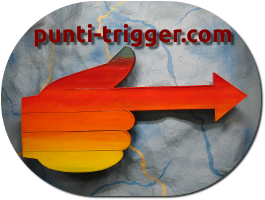The Subscapularis is one of the most ignored external muscles of our body. But every good practitioner of trigger point therapy would do well to make friendship with this stranger.
The Subscapularis is placed between the inner face of the Scapula and the thoracic vertebrae, and is hidden by the shoulder blade and this explains why most people do not even know of its existence.
The muscle originates from the inner concave surface of the Scapula. The fibers converge laterally and superiorly in a tendon that attaches to the Lesser Tubercle of the Humerus and the capsule of the shoulder joint.
The functions of the Subscapularis are essentially two, namely, internal rotation of the arm, and stabilization of movements, especially upward. In addition, the muscle opposes the anterior dislocation of the humerus.
Anatomically, the Subscapularis is one of the four muscles that form part of the functional group of the Rotator Cuff of the shoulder, the other being the Supraspinatus, the Infraspinatus, and the Teres Minor. Chronic shoulder problems are often caused by myofascial syndrome involving this group, but the Subscapularis is frequently the primary cause which then causes the involvement of the other three rotators.
The symptoms of the Subscapularis syndrome are reduced mobility of shoulder and pain.
While the Infraspinatus is the primary responsible for pain in the rotator cuff, the Subscapularis is the main cause (as well as being responsible for pain in the back of the shoulder) for the so-called "frozen shoulder" or marked disfunction with extremely low mobility of the joint.

The pain is located in the back of the shoulder area, in the area of the posterior Deltoid and shoulder blade, with irradiation at times in the area of the triceps and the posterior arm, and often pain referral to around the wrist, which is a little "mark" of trigger points of the Subscapularis. In advanced cases the pain can take incapacitating intensity, both at rest and in motion.
The reduction of mobility concerns both the abduction as well as the external rotation of the Humerus, and, a fortiori, abduction and rotation combined. But since vertically raising your arm requires both movements, it becomes impossible to raise your hand above and behind the head.
Later, with a cascading effect, the antagonists and agonists are involved: the external rotators (Infraspinatus, Teres Minor) are opposed to a chronically shortened Subscapularis, and end up developing trigger points themselves. And since the three muscles keep the humerus in position, it also follows that the joint is compressed excessively, resulting in dysfunction (often characterized by "clicking" or jerky and grinding noises of the shoulder during movement). You can end up with a chronic subluxation of the shoulder, which will lead to joint damage, especially in athletes who ignore the pain and do not take appropriate steps to disable the trigger points.
Eventually the entire shoulder is immobilized in a pain syndrome, which if not treated with appropriate trigger point therapy, can go on for years, often with vague or incorrect diagnoses such as periarthritis, tendonitis, bursitis, adhesive capsulitis, thoracic outlet syndrome and so on, which do not focus the real causes, but often result in toxic infiltrations and inappropriate forced manipulations of the painful joint.
The underlying causes are often a traumatic event such as a fall, or a repetitive effort especially if one is not in good physical shape, such as repeatedly lifting a weight in strong adduction (eg raising a child with both hands) . Perpetuating factors are repetitive movements of internal rotation of the arm, and also a wrong posture of the shoulders abitually rotated forward and inward ("winged scapula"). In addition, forced immobilization in adduction and medial rotation as eg having one's arm in sling cast, lead to the development of trigger points in the Subscapularis.

The trigger points are found in three areas, the first of which is easily accessible, on average, the second of difficult access, and the third is difficult to access.
The first trigger point is in the lower lateral edge of the muscle, where the fibers are essentially almost vertical. The second trigger point is located in the upper region of the muscle, very close to the glenohumeral articulation, where the fibers are essentially horizontal. The third trigger point is located in the medial, i.e. spinal, area.
To access the first two trigger points, the patient is positioned supine, and is asked to bring the arm up with the hand behind the head, if possible. In severe cases, this will still be too painful and then you can grab the humerus with one hand and pull towards the outside, or you ask the person to bring the arm across the chest and place the hand on the opposite shoulder. In any case the concept is to abduct the Scapula to expose, in the armpits, the greatest possibe portion of the muscle that would otherwise be covered by the ribs and inaccessible.
Once so abducted the shoulder blade, the muscle mass is palpated with the thumb, pincer grip or straight hand, pressing against the inner aspect of the Scapula itself, ie if the person and lying face up, pressing downward.
If you have problems identifying the muscle, then ask the person to rotate with force the arm inwards, and this movement will contract the Subscapularis to make it easy to identify.
To locate the trigger points it is important to study the fiber orientation: horizontal at the top, vertical at the bottom.
Be careful not to have long nails because the work on the Subscapularis is carried out mainly in the area of the armpit, and the skin in the armpits is particularly sensitive, so it's important to use the fingertips, to proceed very slowly, and use a good oil.
The third zone, that of the medial or vertebral side, is inaccessible from this angle of attack. To access the spine side, you must place the person to the side or prone position, and then place the patient's forearm behind the kidney posteriorly (to assume a winged scapular position), then approach the trigger points from the innner and posterior side of the scapula with the thumb or straight fingers or pincer fingers. However this area is covered by Trapezius, Rhomboids and Anterior Serratus, so not easy to identify the Subscapularis in this case.
For self-massage, you can rest your hand on the affected side of the opposite shoulder and then push your thumb against the inside shoulder blade, taking care to keep the hand close to the ribs.
Once thumb contact is established with themuscle, starting from the bottom of the shoulder blade, pressure is applied repeatedly and proceed with small strokes toward the outer edge of the shoulder blade. After 5-10 strokes, move the thumb an inch or so up, and repeat the process until you reach the higher aspect of the axilla.
One should proceed with caution because the region is particularly sensitive, rich in lymphatic vessels, and the skin is particularly irritable. The muscle can also be quite painful to pressure, so one should be able to differentiate between pain caused eg, by nails on the skin, from pain caused by pressure on myofascial trigger points (we are after the second type, while the first is to be avoided).

It is to be kept in mind that the Subscapularis should be treated together with the other rotator and the muscles functionally associated with: Teres Minor, Supraspinatus, Infraspinatus, Teres Major, Pectoral Major and Minor, Latissimus Dorsi. Often in chronic shoulder problems, all these muscles are eventually one after the other involved in the myofascial syndrome.
To complete the therapy, is essential to follow a stretching routine. A good procedure that is also suitable for the Pectoralis, is the stretch with the help of a door frame, with the arm externally rotated and abducted upward.
A variation of the stretching of the Subscapularis is shown below.
